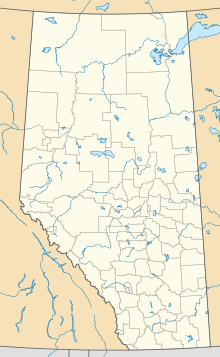Round Hill, Alberta
Round Hill | |
|---|---|
Hamlet | |
 Location of Round Hill in Alberta | |
| Coordinates: 53°09′55″N 112°37′51″W / 53.1653°N 112.6308°WCoordinates: 53°09′55″N 112°37′51″W / 53.1653°N 112.6308°W | |
| Country | Canada |
| Province | Alberta |
| Census division | No. 10 |
| Municipal district | Camrose County |
| Government | |
| • Type | Unincorporated |
| • Governing body | Camrose County Council |
| Area (2021)[1] | |
| • Land | 2.59 km2 (1.00 sq mi) |
| Elevation | 740 m (2,430 ft) |
| Population (2021)[1] | |
| • Total | 125 |
| • Density | 48.3/km2 (125/sq mi) |
| Time zone | UTC−7 (MST) |
| • Summer (DST) | UTC−6 (MDT) |
Round Hill is a hamlet in central Alberta, Canada within Camrose County.[2] It is located on Highway 834 approximately 29 kilometres (18 mi) northeast of Camrose and has an elevation of 740 metres (2,430 ft).
The hamlet is located in Census Division No. 10 and in the federal riding of Crowfoot.
Demographics[]
In the 2021 Census of Population conducted by Statistics Canada, Round Hill recorded a population of 125 living in 54 of its 58 total private dwellings, a change of -3.1% from its 2016 population of 129. With a land area of 2.59 km2 (1.00 sq mi), it had a population density of 48.3/km2 (125.0/sq mi) in 2021.[1]
As a designated place in the 2016 Census of Population conducted by Statistics Canada, Round Hill recorded a population of 129 living in 50 of its 51 total private dwellings, a change of 5.7% from its 2011 population of 122. With a land area of 2.59 km2 (1.00 sq mi), it had a population density of 49.8/km2 (129.0/sq mi) in 2016.[3]
See also[]
References[]
- ^ a b c "Population and dwelling counts: Canada and designated places". Statistics Canada. February 9, 2022. Retrieved February 10, 2022.
- ^ "Specialized and Rural Municipalities and Their Communities" (PDF). Alberta Municipal Affairs. January 12, 2022. Retrieved January 21, 2022.
- ^ "Population and dwelling counts, for Canada, provinces and territories, and designated places, 2016 and 2011 censuses – 100% data (Alberta)". Statistics Canada. February 8, 2017. Retrieved February 13, 2017.
- Camrose County
- Hamlets in Alberta
- Designated places in Alberta
- Central Alberta geography stubs
